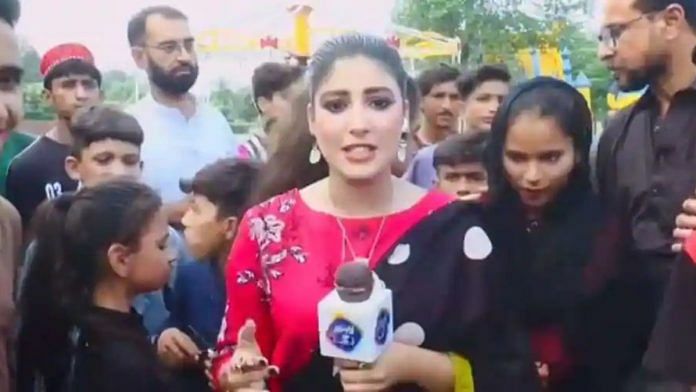New Delhi: A Pakistani reporter who slapped a teenage boy on TV while reporting on Eid al-Adha celebrations Sunday has acquired the moniker ‘Lady Chand Nawab’ after the well-known local journalist who made headlines for doing the same nearly a decade ago. The video clip of the reporter, Maira Hashmi, slapping the young man has gone viral on social media this week.
یہ لڑکا انٹرویو کے دوران فیملی کو تنگ کر رہا تھا _جسکی وجہ سے فیملی پریشان ہوگئی تھی__میں نے پہلے پیار سے سمجھایا کے ایسا نہیں کرو مگر سمجھانے کے باوجود یہ لڑکا نہیں سمجھا اور زیادہ ہُلّڑ بازی کررہا تھا_ جس کے بعد مجھے زیب نہیں دیا کہ اسے اور موقع دیکر برداشت کیا جائے ؟ pic.twitter.com/4jmuSsInYg
— Maira Hashmi (@MairaHashmi7) July 11, 2022
It has given social media users another chance to comment on the state of Pakistan’s broadcast media, where dealing with citizens in a violent manner has become a common practice.
One Twitter user, in support of her, said that she was simply doing her job and did not deserve to deal with such disruptive crowds.
While responding to mounting criticism, Hashmi said that the teen had been repeatedly harassing a father and his daughters during their interview despite politely being asked to stop. It made the family upset. When he behaved in a similar manner again, Hashmi, who works with Lahore Rang, claims she was left with no choice but to slap him.
“It’s not just me here, it’s about every daughter who finds herself on the holy land of the Islamic Republic of Pakistan. The fact is that in the field of journalism, women journalists are seen working in the field. and it is true that women journalists do nothing even after seeing, hearing and enduring everything and are silent out of fear for the sake of honor. But how long will this happen,” Hashmi told ThePrint.
She said that should something like this happen again, she would make the same ‘mistake’.
Lahore Rang, a local news channel, hasn’t issued a statement supporting or condemning her actions.
Split reactions
Several users on Twitter also called her action impulsive and unnecessarily violent—with some going on to label it as ‘child harassment.’
A user went on to vouch for the teen’s innocence, saying there is no evidence that proves he was harassing the family.
Lame excuse
Uska qasoor ye tha k tumhary camera k samny hath aya uska.
Aur tum ny thapar mara.
Agr family ko.tung kr raha tha toh uski video kahan hai
— Ali Mazhar (@Ali_Mazharr) July 11, 2022
Another said she had no right to take matters into her own hand and use force, adding that she could be subjected to legal penalties.
Some saw it as a publicity stunt because Hashmi posted the video on her social media before it went public.
But this video was uploaded by you on your tiktok account before anyone. Clearly you shared it for attention seeking. Or we can call it a publicity stunt.
— ? (@ayesha_117) July 11, 2022
The vast majority, however, found the situation funny.
Pakistani journalist Naila Inayat tweeted the video with an ironic caption, asking viewers, “So how was your day?”
So how was your day? pic.twitter.com/FqOxNNmlBc
— Naila Inayat (@nailainayat) July 11, 2022
Reporters slapping bystanders not new
Time and again, live news in Pakistan has seen journalists getting violent with bystanders who seem to be causing some sort of chaos or disturbance in the reporting process. And the internet does not leave such opportunities—making viral memes and gags after these incidents.
Reporter Chand Nawab, in a similar instance, became a popular figure on the internet when videos of him fumbling on camera and later, slapping a child who came in his way, were widely circulated. In fact, he even inspired Nawazuddin Siddiqui’s character in Bajrangi Bhaijaan.
Another journalist, who was also reporting on Eid celebrations in 2013, rather violently slapped a child who seemed to want to show his face on camera.
Reporters, too, have been victims of violence. In 2016, journalist Saima Kanwal, then reporting for the K21 News Channel in Karachi, was slapped by a paramilitary trooper in the middle of her story. The officer was enraged after Saima accused him of misbehaving with public. The case led to questions about sexism in Pakistan media. But an increasing number of anchors in Pakistan refuse to stand on the sidelines and remain bystanders.
(Edited by Zoya Bhatti)






